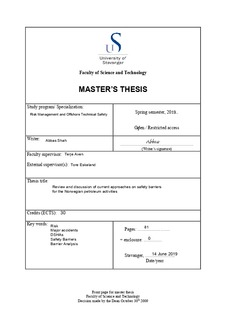| dc.description.abstract | Over the past forty years, hydrocarbon industry is the largest revenue generating industry in Norway. The hydrocarbon activities carried out in the Norwegian continental shelf (NCS) are associated with major accident potential and very high-risk levels. Hence, safety to human life, assets and environment becomes an issue of great significance. Accident investigations show that poor risk assessments and failure of safety barriers are the leading causes of major accidents in the offshore petroleum industry (Johansen & Rausand, 2015). The Petroleum Safety Authority (PSA) is a government supervisory and administrative agency with regulatory responsibility for safety, security, the work environment and emergency preparedness in the hydrocarbon sector of the NCS. PSA has been keen on increasing the competence and understanding of the criticality of the safety barriers in order to prevent and control the propagation of major accidents (PSA, 2017). Management regulations of PSA provide several references to safety barriers. Despite the fact that PSA has clearly signified barriers imminence, few operators in the industry still fail to implement the regulatory requirements regarding the safety barriers (Gustafson, 2014). This is because, various operators in the industry have unclear concepts regarding the key terminologies related to safety barriers and are ambiguous about the link between risk and safety barriers. This report provides an inclusive review and detailed discussion on safety barriers in the NCS. The objective of this master thesis is to review the existing concepts related to safety barriers in the NCS and suggest a comprehensive workflow for barrier analysis so that better decision making while establishing and implementing safety barriers can be guaranteed. A thorough barrier analysis can also help in ensuring safe and sustainable petroleum activities in the NCS. Moreover, developing a clear link between risk assessment and safety barriers optimization of barrier functionality can be enhanced and major accidents can be significantly reduced in the offshore hydrocarbon industry. | nb_NO |
